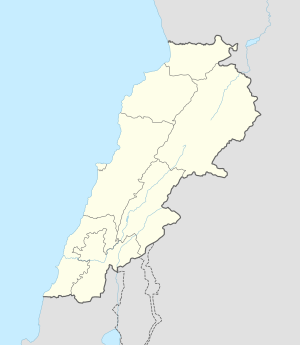Maghdouché
|
Maghdouché مغدوشة |
||
|---|---|---|
| Town | ||
 |
||
|
||
| Location in Lebanon | ||
| Coordinates: 33°31′20″N 35°23′9″E / 33.52222°N 35.38583°ECoordinates: 33°31′20″N 35°23′9″E / 33.52222°N 35.38583°E | ||
| Country |
|
|
| Governorate | South Governorate | |
| District | Sidon District | |
| Government | ||
| • Type | Mayor-council | |
| • Body | Maghdouche municipality | |
| Highest elevation | 230 m (755 ft) | |
| Time zone | EET (UTC+2) | |
| • Summer (DST) | EEST (UTC+3) | |
| Dialing code | 00961 (7) Landline | |
Maghdouché (Arabic: مغدوشة, English: Maghdouche, French: Maghdouché) is a town in the South Governorate in Lebanon. It is located 50 km south of Beirut and 8 km southeast of Sidon. The village lies 3 km inland from the Mediterranean, occupying a hill with elevation ranging between 200 and 229 meters above sea level.
Maghdouché has a permanent population of 8,000 inhabitants, the majority of whom are Melkite Catholics and few Maronite Catholics. The population of the town doubles when the expatriates return to spend their summer vacations in their ancestral home. The village and some adjacent villages and others in the south, were previously full or partially owned by a Greek family that chose to reside and integrate in Lebanon since over a century.
Maghdouche and adjacent christian villages are currently facing political/religious complexes and challenge that mistakenly enforced building/zoning restrictions on christian land owners, thinking that it would fight demographic changes, while it is actually pooring the community and limiting area development.
Maghdouché's main industry is agriculture. The town produces grapes and citrus fruits, especially oranges. The town is famous for its best quality orange-blossom water. On April 2006, USAID funded a $195,000 cooperative of flower blossom and rose water production center, which will serve more than 950 farmers in the Magdhouche area.
The name, Maghdouché, originates from the Syriac word, which means "crop collectors." It is also derived from the Syriac word Kidsh and its derivatives (Kadisho, Kadishat, Makdosho). In Hebrew, it means "holy" or "saintly." According to Christian belief, when Jesus came to Sidon, the Virgin Mary who accompanied him, waited for him at the top of the hill where Maghdouché is located today. She spent the night in a cave that came to be known as Mantara, or the "Awaiting." Emperor Constantine the Great responded to St. Hélène's request and transformed the cave into a sanctuary for the Virgin. He erected a tower in honor of the Virgin. The tower collapsed during the earthquake of 550. Later, King Louis IX erected a watching tower in the same location. The Mantara cave was once again discovered accidentally by a shepherd in 1726. An icon of the Virgin was also discovered, and it was of Byzantine style, dating back to the 7th or to the 8th century. Since then, the cave has been transformed into a place of pilgrimage for all the Lebanese confessions. In 1860, the Greek Catholic Church became the owner, and transformed the cave into a sanctuary in 1880.
...
Wikipedia


